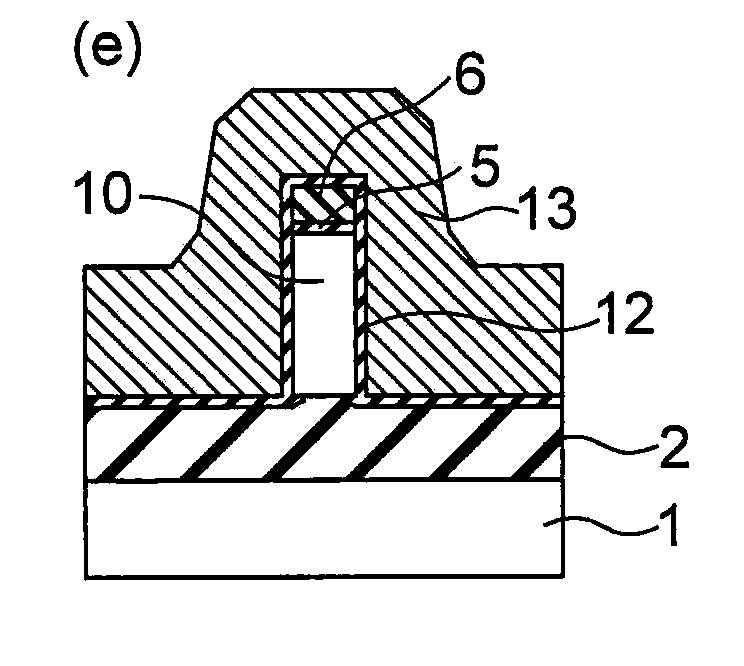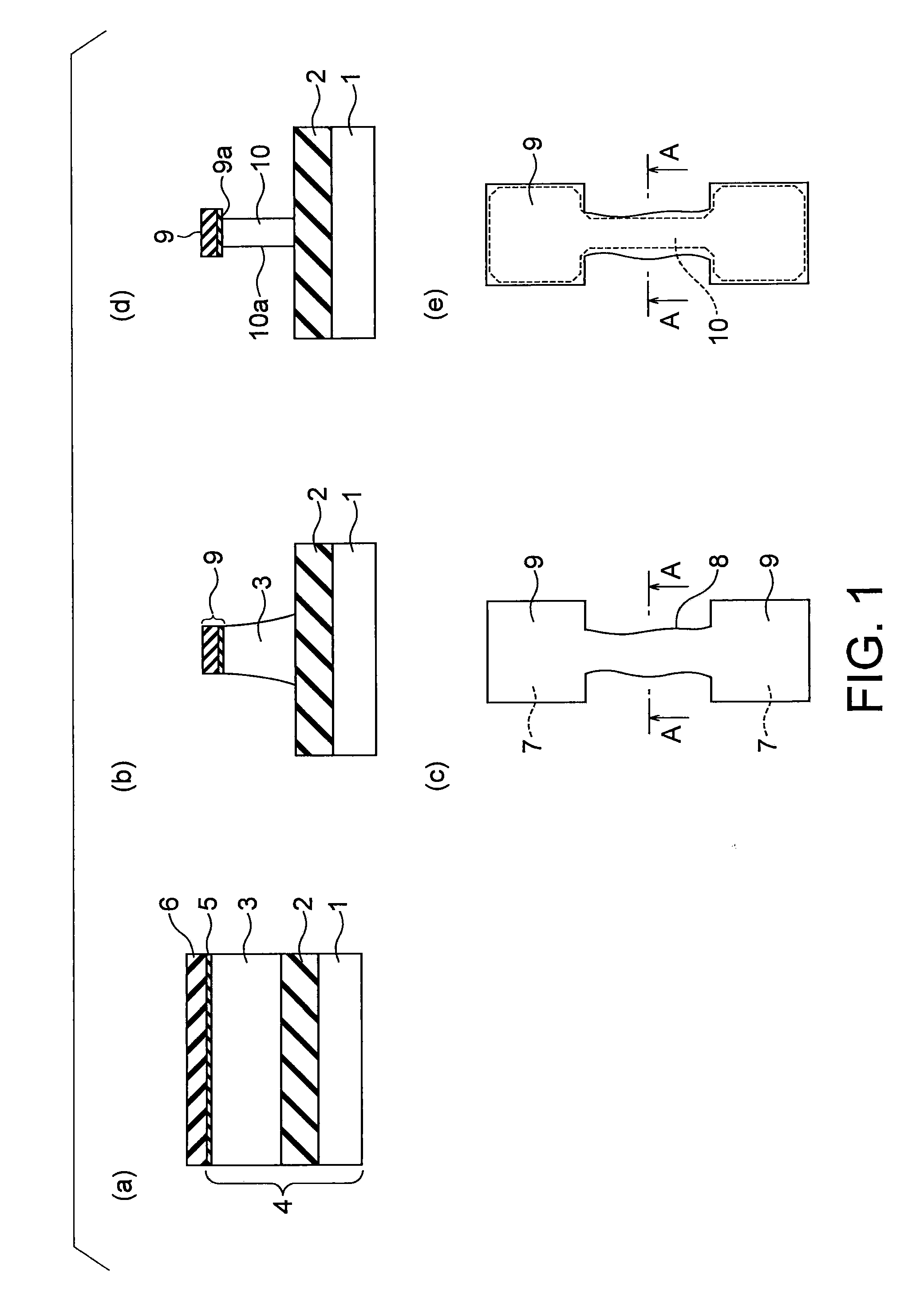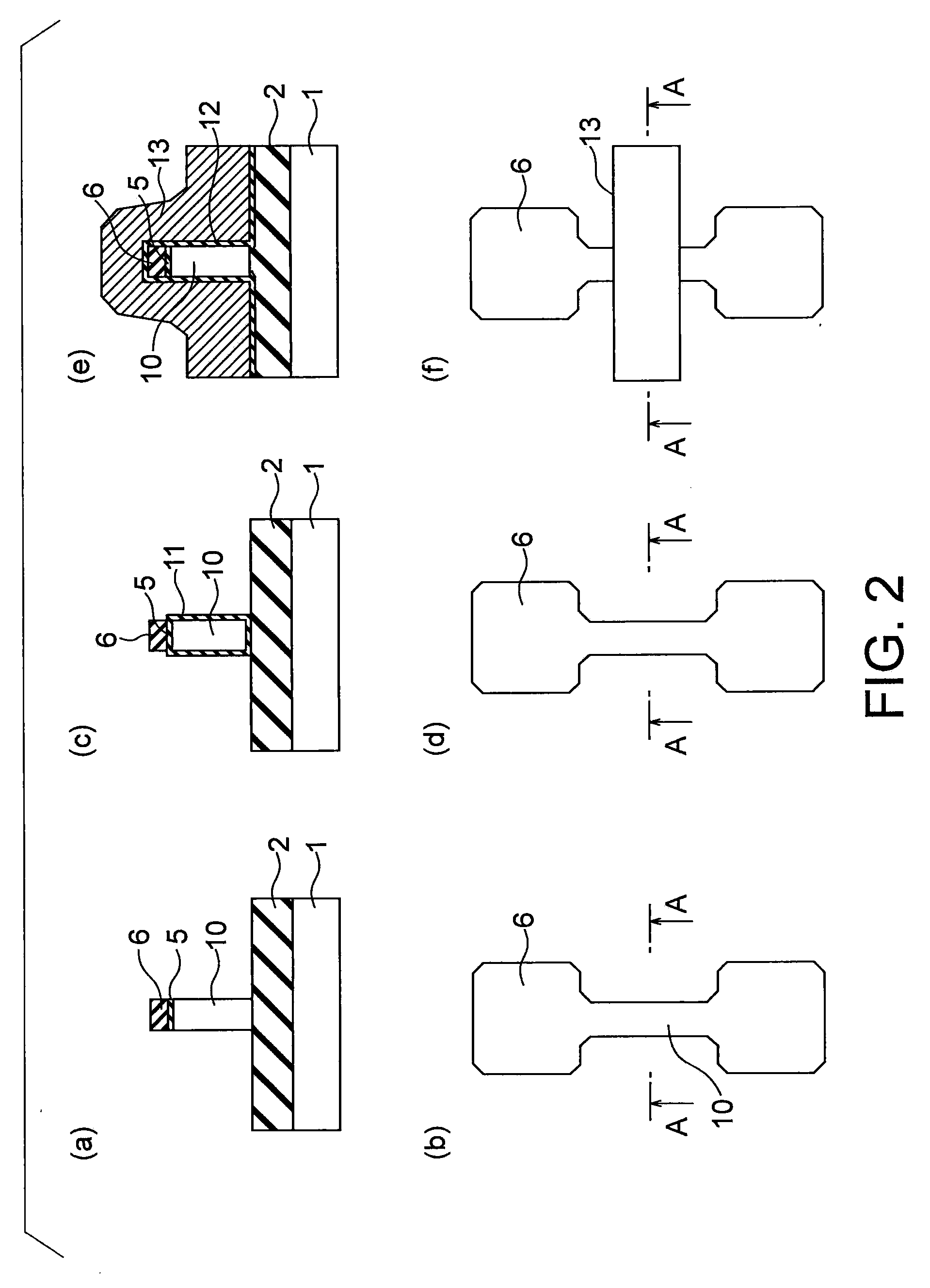Field Effect Transistor and Method for Manufacturing the Same
a field effect transistor and transistor technology, applied in the direction of basic electric elements, electrical equipment, semiconductor devices, etc., can solve the problems of reducing the width of the fin to approximately 10 nm or less, causing size and shape variations, and achieving the smallest possible channel width , the effect of smallest possible size and shape variation
- Summary
- Abstract
- Description
- Claims
- Application Information
AI Technical Summary
Benefits of technology
Problems solved by technology
Method used
Image
Examples
first embodiment
[0050]Referring to FIGS. 1(a) to 2(f), a method for manufacturing a field effect transistor in accordance with a first embodiment of the present invention is described. FIGS. 1(a), 1(b), 1(d), 2(a), 2(c), and 2(e) are cross-sectional views illustrating procedures to be carried out by the method for manufacturing the field effect transistor in accordance with this embodiment. FIGS. 1(c), 1(e), 2(b), 2(d), and 2(f) are plan views. FIGS. 1(b), 1(d), 2(a), 2(c), and 2(e) are cross-sectional views, taken along each line A-A of FIGS. 1(c), 1(e), 2(b), 2(d), and 2(f).
[0051]The field effect transistor manufactured by the manufacture method in accordance with this embodiment is a Fin FET that has a channel made of Si.
[0052]First, as shown in FIG. 1(a), a SOI substrate 4 having a supporting substrate 1, a buried oxide film 2, and a 50-nm thick SOI layer 3 having a (001) plane as the principal surface is prepared. A 2-nm thick silicon oxide film 5 and a 20-nm thick silicon nitride film 6 are d...
second embodiment
[0076]Referring now to FIGS. 4(a) to 6(f), a method for manufacturing a field effect transistor in accordance with a second embodiment of the present invention is described. FIGS. 4(a) to 4(c) are cross-sectional views illustrating the procedures to be carried out by the manufacture method in accordance with this embodiment. FIGS. 5(a), 5(c), 5(e), 6(a), 6(c), and 6(e) are cross-sectional views illustrating procedures to be carried out by the method for manufacturing the field effect transistor in accordance with this embodiment. FIGS. 5(b), 5(d), 5(f), 6(b), 6(d), and 6(f) are plan views. FIGS. 5(a), 5(c), 5(e), 6(a), 6(c), and 6(e) are cross-sectional views, taken along each line A-A of FIGS. 5(b), 5(d), 5(f), 6(b), 6(d), and 6(f).
[0077]The manufacture method in accordance with this embodiment is a method for manufacturing a nanowire MOSFET having nanowires formed with strained SiGe.
[0078]First, as shown in FIG. 4(a), a SOI substrate 4 having a supporting substrate 1, a buried oxi...
third embodiment
[0095]Referring now to FIGS. 7(a) to 7(f), a method for manufacturing a field effect transistor in accordance with a third embodiment of the present invention is described. FIGS. 7(a), 7(c), and 7(e) are cross-sectional views illustrating procedures to be carried out by the method for manufacturing the field effect transistor in accordance with this embodiment. FIGS. 7(b), 7(d), and 7(f) are plan views. FIGS. 7(a), 7(c), and 7(e) are cross-sectional views, taken along each line A-A of FIGS. 7(b), 7(d), and 7(f).
[0096]The manufacture method in accordance with this embodiment is another method for manufacturing a nanowire MOSFET having nanowires formed with strained SiGe.
[0097]First, a SOI substrate 4 having a supporting substrate 1, a buried oxide film 2, and a 30-nm thick SOI layer 3 having a (001) plane as the principal surface is prepared. The same procedures as those of the first embodiment illustrated in FIGS. 1(d) and 1(e) are then carried out. More specifically, the same proce...
PUM
 Login to View More
Login to View More Abstract
Description
Claims
Application Information
 Login to View More
Login to View More - R&D
- Intellectual Property
- Life Sciences
- Materials
- Tech Scout
- Unparalleled Data Quality
- Higher Quality Content
- 60% Fewer Hallucinations
Browse by: Latest US Patents, China's latest patents, Technical Efficacy Thesaurus, Application Domain, Technology Topic, Popular Technical Reports.
© 2025 PatSnap. All rights reserved.Legal|Privacy policy|Modern Slavery Act Transparency Statement|Sitemap|About US| Contact US: help@patsnap.com



